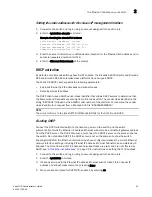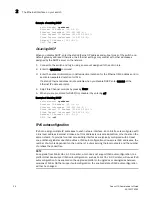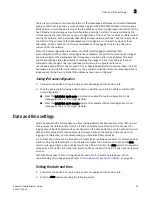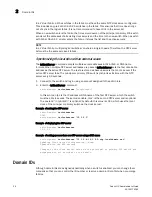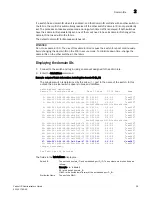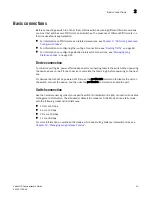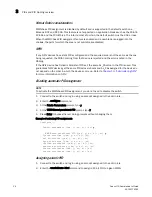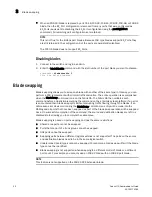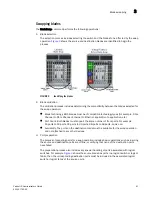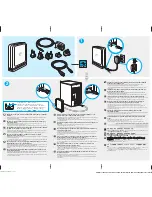
Fabric OS Administrator’s Guide
37
53-1001763-02
PIDs and PID binding overview
3
•
Any port on a 48-port blade can support up to 256 NPIV devices (in fixed addressing mode,
only 128 NPIV devices are supported in non-VF mode and 64 NPIV devices in VF mode on a
48-port blade).
•
Any port on a 48-port blade can support loop devices.
•
Any port on a 48-port blade can support hard port zoning.
•
Port index is not guaranteed to be equal to the port area_ID.
256-area addressing mode
This configurable addressing mode is available only in a logical switch on the Brocade DCX and
DCX-4S platforms. In this mode, only 256 ports are supported and each port receives a unique
8-bit area address. This mode can be used in FICON environments, which have strict requirements
for 8-bit area FC addresses.
There are two types of area assignment modes in the 256-area addressing mode: zero-based and
port-based. Zero-based mode, which assigns areas as ports, are added to the partition, beginning
at area 0x00. This mode allows FICON customers to make use of the upper ports of a 48-port
blade; but this mode may not be compatible with
domain,index
zoning in InteropMode 2, because
M-EOS switches are not capable of handling indexes greater than 255. In both zero-based and
port-based modes, you can assign from the entire range 0x00 to 0xff for the PID. Port-based mode
does not support the upper 16 ports of a 48 port blade in a logical switch.
WWN-based PID assignment
WWN-based PID assignment is disabled by default. When the feature is enabled, bindings are
created dynamically; as new devices log in, they automatically enter the WWN-based PID database.
The bindings exist until you explicitly unbind the mappings through the CLI or change to a different
addressing mode. If there are any existing devices when you enable the feature, you must manually
enter the WWN-based PID assignments through the CLI.
This feature also allows you to configure a PID persistently using a device WWN. When the device
logs in to the switch, the PID is bound to the device WWN. If the device is moved to another port in
the same switch, or a new blade is hot plugged, the device receives the same PID (area) at its next
login.
Once WWN-based PID assignment is enabled you must manually enter the WWN-based PID
assignments through the CLI for any existing devices.
ATTENTION
When WWN-base PID assignment is enabled, the area assignment is dynamic and does not
guarantee any order in the presence of static wwn-area binding or when the devices are moved
around.
PID assignments are supported for a maximum of 4096 devices; this includes both point-to-point
and NPIV devices. The number of point-to-point devices supported depends directly on the areas
available. For example, 448 areas are available on an enterprise-class platform and 256 areas are
available on switches. When the number of entries in the WWN-based PID database reaches 4096
areas are used up, the oldest unused entry is purged from the database to free up the reserved
area for the new FLOGI.
Summary of Contents for 53-1001763-02
Page 1: ...53 1001763 02 13 September 2010 Fabric OS Administrator s Guide Supporting Fabric OS v6 4 0 ...
Page 4: ...iv Fabric OS Administrator s Guide 53 1001763 02 ...
Page 24: ...xxiv Fabric OS Administrator s Guide 53 1001763 02 ...
Page 28: ...xxviii Fabric OS Administrator s Guide 53 1001763 02 ...
Page 32: ...xxxii Fabric OS Administrator s Guide 53 1001763 02 ...
Page 40: ...xl Fabric OS Administrator s Guide 53 1001763 02 ...
Page 42: ...2 Fabric OS Administrator s Guide 53 1001763 02 ...
Page 54: ...14 Fabric OS Administrator s Guide 53 1001763 02 High availability of daemon processes 1 ...
Page 74: ...34 Fabric OS Administrator s Guide 53 1001763 02 Basic connections 2 ...
Page 102: ...62 Fabric OS Administrator s Guide 53 1001763 02 Audit log configuration 3 ...
Page 214: ...174 Fabric OS Administrator s Guide 53 1001763 02 Management interface security 7 ...
Page 228: ...188 Fabric OS Administrator s Guide 53 1001763 02 Brocade configuration form 8 ...
Page 276: ...236 Fabric OS Administrator s Guide 53 1001763 02 Creating a logical fabric using XISLs 10 ...
Page 404: ...364 Fabric OS Administrator s Guide 53 1001763 02 ...
Page 440: ...400 Fabric OS Administrator s Guide 53 1001763 02 Performance data collection 17 ...
Page 480: ...440 Fabric OS Administrator s Guide 53 1001763 02 F_Port masterless trunking 19 ...
Page 494: ...454 Fabric OS Administrator s Guide 53 1001763 02 Buffer credit recovery 20 ...
Page 574: ...534 Fabric OS Administrator s Guide 53 1001763 02 Hexadecimal overview E ...

